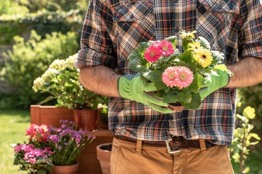Brief guide on garden maintenance during shemitah

How can I take care of my garden during shemitah? A short, practical article
Private individuals may not sow plants or turn over the soil to aerate it.
It is permitted to water plants to keep them alive.
It is sufficient to fertilize home gardens with slow-release fertilizer before shemitah to provide the garden with all of its nourishment needs. Do not fertilize during shemitah.
Weeds
Weeds that considerably mar the garden's appearance or compete with the plants in the garden; or if the weeds could provide cover for various pests, the order of preference is as follows:
a. Spray with various herbicides.
b. Cover the area in a black sheet (that blocks light).
c. Spray existing weeds (available as mentioned above).
d. Mow down weeds above soil (with a lawnmower or motorized scythe, etc.).
Do not uproot weeds.
Pruning
When pruning is meant only to preserve the existing shape of the tree or bush is permitted, providing that the plant is mature and the pruning does not initiate new growth. For this reason, it is permissible to prune a full living fence or gate. However, it is forbidden to prune a young living fence, since pruning initiates the growth of new branches that fill in the gaps.
It is permissible to prune in the following cases: protruding branches next to (or above) sidewalks that bother pedestrians or growing near electrical wires and such. In such cases, pruning is permissible, providing that it is apparent that the purpose is not to facilitate the tree's growth and it is done with a shinuy (not in a way that is best for the tree, for instance).
Mowing the lawn
Full lawns without bald spots can be mowed as usual. One should not be late in mowing; otherwise, this causes lawn yellowing (sunburn), which initiates new growth.
It is forbidden to mow young grass, as this causes it to spread.
It is forbidden to perform actions that are meant to sprout new fruit on the tree (such as irrigation and fertilization during blooming). However, after the fruit begins to develop, it is permissible to perform such actions to preserve the existing fruit. These actions include: spraying against pests that harm fruit, spraying to prevent fruit from falling, clipping thorns that harm fruit (for etrogim only, since thorn punctures disqualify them), tying and training branches, and bending branches prior to harvest to make fruit harvest easier.
It is permissible to perform landscaping work for the purpose of construction but not for the purpose of planting and sowing plants and trees.
Growing indoors
The laws of shemitah do not apply to growing crops indoors when the growing platform is detached from the ground.
For a structure to be considered a house (indoors), it should be permanent and not mobile.
Planters should be placed on a platform detached from the ground. When growing plants indoors, if on the first floor or higher, there is no need for an additional surface to detach plants from the ground. If on the ground floor, use another material under the pot: strong polyethylene plastic sheets; coated, waterproof Palrig sheets; and galvanized metal panels, etc.
The volume of each planter may not exceed 70 L. The size of the perforation in the planter should not exceed 1 cm²; all perforations in the planter together should not exceed 2 cm².
For more on growing indoors, see here. For more on home gardens, see Chapter 22 of our Consumer's Guide to Shemitah, here.




